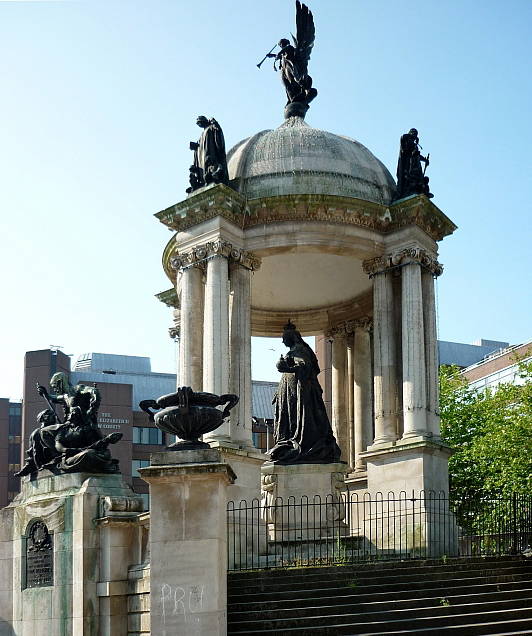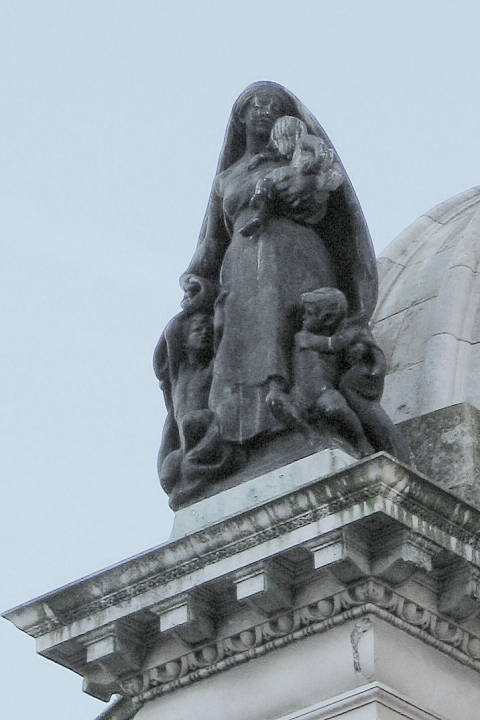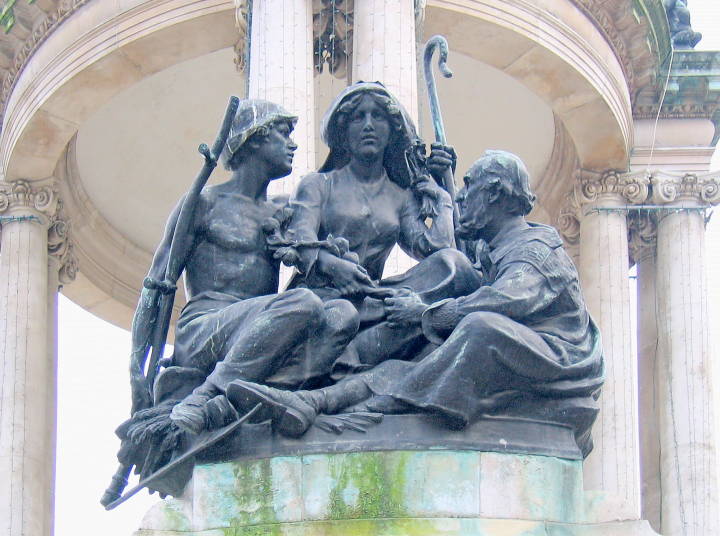
Queen Victoria Monument, by Charles John Allen (1862-1956). 1902-1906. Located in Derby Square, Liverpool.




Left to right: (a) and (b) Queen Victoria. (c) Side view of the monument, showing Queen Victoria standing beneath a dome (the figure at the left represents Industry (see detail). (d) A winged figure with a trumpet, representing Fame, surmounting the dome; the figure below Fame is Charity (see detail). [Click on these and following images to enlarge them.]
Terry Cavanagh discusses the monument at some length, relaying the suggestion made in the Daily Post and Mercury that the allegorical groups around the base of the dome represent the Queen's personal virtues: "Justice, Wisdom, Charity and Peace" (38). A sketch model of Charity was exhibited at the Walker Art Gallery's Autumn Exhibition of 1903. As for the allegorical groups on the pedestals around the central podium, Education is perhaps the most interesting, since the figure wearing academic robes over his modern dress here was modelled on Sir Oliver Lodge (1851-1940), Professor of Physics and Mathematics at the University of Liverpool, and later the first principal of Birmingham University. He is seen here studying the action of a scientific instrument, with one student looking on with evident fascination, while another is immersed in a book. Allen's marble bust of Sir Oliver is in the University of Liverpool's collection.




Left to right: (a) A view of the monument with the group representing Education in the foreground. (b) Fame. (c) Charity. (d) Industry.
For all its size, scope and interest, the Queen Victoria monument was not without its detractors. The canopy from the start was considered its "least successful feature" (Cavanagh 43), and as early as 1908 the Town Clerk was complaining about the mottling of the Portland stone, and the green staining from the bronze. Nevertheless, this is still generally seen as Allen's "magnum opus" and (which is saying a great deal) "one of the most ambitious British monuments to the Queen" (Pollard and Pevsner 321).



Left to right: (a) Commerce. (b) Education. (c) Agriculture.
Allen's monument to Victoria interestingly combines a typically graceful "new sculpture" angel, a realistic depiction of the aged queen, and allegorical figures in modern dress. The nineteenth century had seen an intense debate about how to render contemporary people in sculpture, one group arguing that since contemporary clothing continually changed, any attempt to capture the details of dress would quickly become dated and therefore one had to create a kind of classicizing timelessness — something much easier to achieve when representing royalty, academics in their regalia, or those in the robes the nobility wore on state occasions, such as we see in Mario Raggi's 1883 Lord Beaconsfield (Benjamin Disraeli) in Parliament Square, London, or Frederick W. Pomeroy's Lord Dufferin in Belfast. Some, like Sir Richard Westmacott in his George Canning, chose to portray contemporary figures in Roman garb while others tried a somewhat desperate compromise by draping large amounts of fabric over a figure in contemporary clothing — the approach taken by the sculptor of George Elliot-Murray-Kynynmound, 1st Earl of Minto in the India Office interior at Whitehall. In contrast, the eldest figure in Allen's Commerce wears a modern hat, necktie, and overcoat.
Captions and photographs by Robert Freidus and Jacqueline Banerjee. Commentary below by Banerjee and George P. Landow. Many thanks to Albert Hickson for alerting us to the mistakes that crept into this piece when later work was added. [You may use these images without prior permission for any scholarly or educational purpose as long as you (1) credit the photographer and (2) link your document to this URL in a web document or cite it in a print one.]
Bibliography
Beattie, Susan. The New Sculpture. New Haven: Yale University Press, 1983.
Cavanagh, Terry. Public Sculpture of Liverpool. Liverpool: Liverpool University Press, 1997.
Pollard, Richard, and Nikolaus Pevsner. Buildings of England: Lancashire: Liverpool and the Southwest. New Haven: Yale University Press, 2006.
Content last modified 13 April 2011